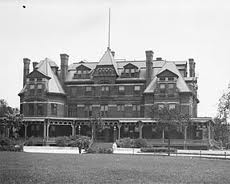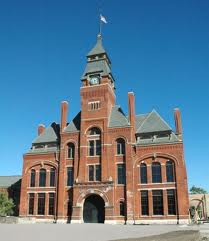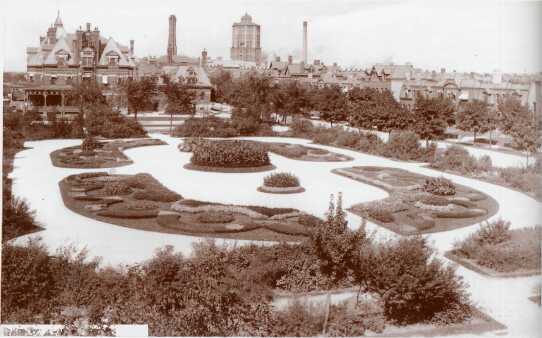By Siraj Asfahani | October 24, 2011
 In April 1991, under former Governor James R. Thompson, the State of Illinois purchased the Pullman Palace Car Company Factory Complex and the adjacent Florence Hotel as part of a newly established state historic site. Those of you may recall from your college history or urban planning classes that Pullman was one of the country’s first planned communities — a company town established by George Pullman in 1880 to locate and house both his large Pullman railroad car factory complex and his factory workers in brick Queen Anne-styled row homes. Pullman was a model company town planned with the latest innovations, such as indoor plumbing and gas lighting, along with a suburban garden park design that included winding streets and ample landscaping. The Pullman company town experiment ended in the mid 1890s when the famous Pullman labor strike spurred a state-ordered sale of the company’s residential assets. The factories remained open until the early 1980s.
In April 1991, under former Governor James R. Thompson, the State of Illinois purchased the Pullman Palace Car Company Factory Complex and the adjacent Florence Hotel as part of a newly established state historic site. Those of you may recall from your college history or urban planning classes that Pullman was one of the country’s first planned communities — a company town established by George Pullman in 1880 to locate and house both his large Pullman railroad car factory complex and his factory workers in brick Queen Anne-styled row homes. Pullman was a model company town planned with the latest innovations, such as indoor plumbing and gas lighting, along with a suburban garden park design that included winding streets and ample landscaping. The Pullman company town experiment ended in the mid 1890s when the famous Pullman labor strike spurred a state-ordered sale of the company’s residential assets. The factories remained open until the early 1980s.
Today, what remains of the Pullman factory complex include the dominant Clock Tower Administrative Building, the North Factory Wing, the Rear Erecting Shops, where the famous Pullman sleeping cars were manufactured, and the Florence Hotel, all designed by Pullman’s architect Solon S. Bemen. Unfortunately, the Administrative Building’s South Factory Wing was lost in a devastating fire in 1998. The Pullman residential neighborhoods largely survive and, along with the remnants of the Factory Complex, comprise one of Chicago’s region’s few National Historic Landmark Districts.
Pullman is not just any historic neighborhood. For me, on a personal level, Pullman is one of those few places that can truly captivate. When walking the neighborhood, you can sense the history and the many stories within the walls of the preserved Pullman homes, the extant buildings of the Factory Complex, and the Florence Hotel, which was named after Pullman’s oldest daughter. Unfortunately, it remains mothballed today by the State of Illinois pending future use. When Lakota was invited by the Chicago District Council of the Urban Land Institute (ULI) a few weeks ago to participate on a Technical Assistance Panel to determine future reuse scenarios for the State Historic Site, we gladly accepted the invitation to assist the State and the Pullman neighborhood reactivate this important site in the City’s and nation’s history.
The Technical Assistance Panel, put together by Chicago ULI and comprised of real estate developers, market analysts, and historic preservation professionals from around the Chicago area, was requested by the Illinois Historic Preservation Agency to figure out ways in which the Factory Complex and the Florence Hotel can be reused through private sector involvement. Lakota was asked to provide its expertise in urban design and preservation and neighborhood planning. Michael Szkatulski, Senior Managing Director of Mesirow Financial in Chicago was the Panel’s Chair. Other preservationists on the Panel included Allen Johnson of MacRostie Historic Advisors and Diane Williams of Business Districts Inc. The Panel met on October 17 and 18 at the Harborside International Golf Club, just a short pike east down 111th Street from Pullman.
The assignment was particularly challenging given the size and physical layouts of the Administrative Building and factory wings, which have also been largely underutilized and vacant since the State’s 1991 purchase. The 1998 fire further set back plans and efforts by IHPA to reuse the buildings as museum space and to transform the site as a cultural tourism destination. The Florence Hotel had recently been used as a restaurant, operated by the Historic Pullman Foundation until 2000 when the IHPA closed the facility for an extensive a $3.4 million repair and restoration project. Finding a private-sector developer and operator that has the experience and capacity to work with large historic buildings and accomplish a building reuse program in a tough economic climate may perhaps be the most significant challenge. It is not often that state preservation agencies bid out the work of restoring, reusing and operating historic sites to the private sector although, given the age of tight state budgets, establishing effective public-private partnerships to leverage financial resources may be looked at more closely by state governments.
At the end of the two-day visit to Pullman, the Technical Assistance Panel presented several preliminary findings to IHPA representatives as well as other key neighborhood stakeholders including Alderman Anthony Beale of the 9th Ward and Eleanor Gorski, Assistant Commissioner for the City of Chicago’s Department of Housing and Economic Development, Historic Preservation Division. One overarching recommendation was the establishment of a private-sector non-profit corporation that could work in tandem with IHPA to secure multiple financing sources and find new uses for the Factory Complex and Florence Hotel. It could also act as the master developer for the site. For its contribution, Lakota recommended the need for an overall management plan that builds on previous preservation and site planning recommendations made in previous (and unimplemented) planning studies and reports. Enhancing the overall urban design and physical appearance of the Pullman neighborhood, through streetscape, wayfinding and other green space improvements were also suggested as ways to tie the neighborhood and State Historic Site together as a cohesive historic environment for both residents and visitors.
The highlight of the Pullman visit for me was not so much the intense two days of interviewing stakeholders and group discussions, but the neighborhood reception that was organized by the Historic Pullman Foundation during the evening of the first day of our visit. It was an excellent opportunity for the Panel to meet a wider cross-section of neighborhood, including many residents who have meticulously preserved and maintained their Pullman homes over the years. Of the residents I talked to, there is clearly a strong bond between them and the history and architecture that defines the place. They also hold the promise that the State Historic Site will eventually become the functioning, vibrant part of the neighborhood that it once was. After 20 years since the State’s purchase, it is hoped that ULI’s Technical Assistance Panel will help pave the way to fulfill that promise.
For more information on the Pullman State Historic Site Technical Assistance Panel and the release of the final report, visit www.chicago.uli.org.




